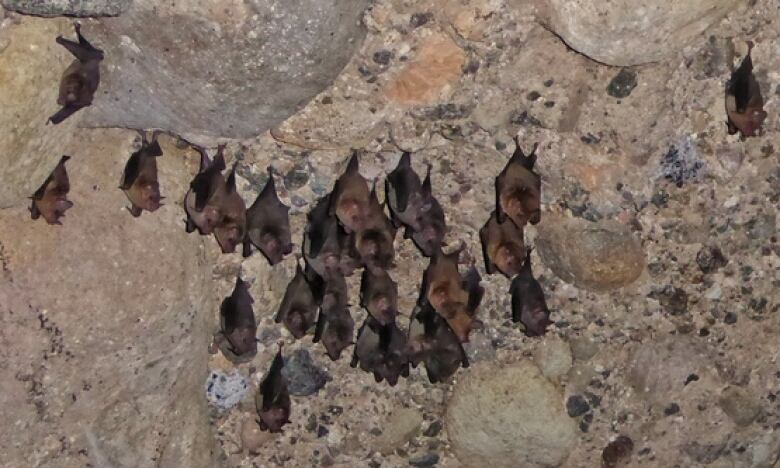Banff hibernating bat discovery has researchers 'super surprised'
No signs of deadly white-nose syndrome spotted in these bats yet, says Parks Canada

For the first time, hibernating bats have been discovered in a cave in Banff National Park.
Researchers were "super surprised but also heartened" that the bats appeared to be in "excellent condition," said Anne Forshner, Parks Canada's lead bat researcher in Banff, Yoho and Kootenay National Parks.
The find is especially encouraging because hibernating bats are most susceptible to a deadly fungal disease known as white-nose syndrome that has already killed roughly six million bats in Canada and the U.S.
Parks Canada staff apparently stumbled across two bats while changing batteries in a bat sound monitor there, said Brian Keating, a wildlife columnist for CBC's The Homestretch and Radio Active.
Researchers speculate that the bats are endangered Little Brown Myotis, more commonly known as mouse-eared bats, but they are waiting for final confirmation from a genetics laboratory in British Columbia.
- Brian Keating swims alongside La Paz's mysterious whale sharks
- Brian Keating explores Magdalena Bay's grey whale 'nurseries'
Fungal disease spreading west
White-nose syndrome was first documented in New York in 2006 and in Eastern Canada in 2010, but has since spread as far west as Thunder Bay.
The disease interrupts hibernation and forces bats to quickly deplete the fat reserves they rely on through the winter, which can leave them vulnerable to fatal dehydration or starvation.
It is believed that cavers may be unknowingly spreading the disease by failing to properly decontaminate their gear, so Parks Canada staff are now trying to stop the westward spread by educating cavers on proper technique.
Few bat species overwinter in Alberta
There are nine species of bats in Alberta, and Banff is believed to have at least six — but most of those species migrate to the U.S. or Mexico during the winter.
"When you think about it, Canada's a pretty tough place to overwinter in the speciation of bats," Keating said.
"They have to find the perfect cave with the perfect temperature and perfect humidity to survive a Canadian winter."
Because there are very few species of bat that overwinter in Alberta, Keating said it's highly likely that these bats are in fact Little Brown Myotis.
Pallas's long-tongued bats
Keating, who has recently returned from Mexico, also came across interesting species of bat there, including the nectar-feeder bat called the Pallas's long-tongued bat.
"They've got the fastest metabolism ever recorded in a mammal, period — as fast as a hummingbird."

The bat uses 50 per cent of its stored fat over the course of a day, but over 80 per cent of its energy comes directly from the simple sugars that compose its diet of nectar.
Elongated hairs at the tongue's tip, which lie flat, become engorged with blood when the tongue is protruded, and as a result the hairs stand erect.
The tongue tip increases by over 50 per cent in length and essentially creates an efficient mop.
The efficiency of this feeding mechanism is believed to enable the bats' survival on limited food sources.
"They need to get as much nectar as possible, as quickly as possible, to fuel their energy-intensive lifestyle," he said.
You can follow Keating's adventures online on Twitter and Facebook.
